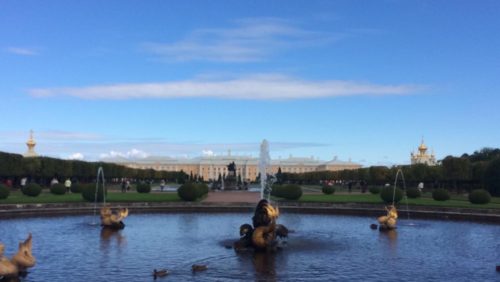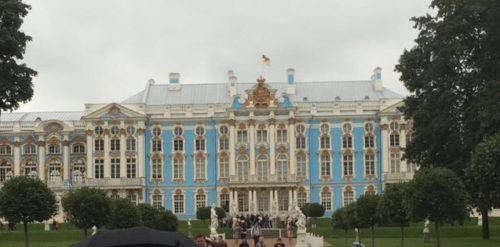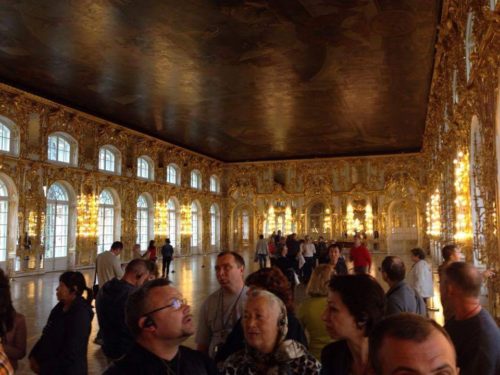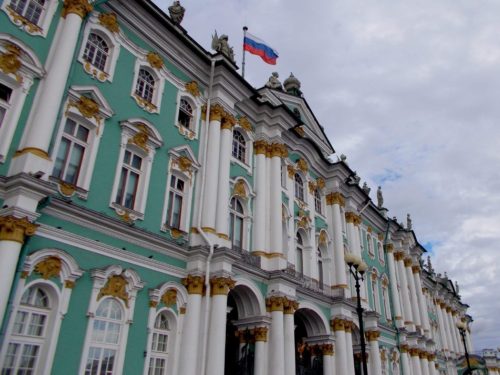I’ve been in Russia for about three weeks now. I can ride public transportation with confidence. I’ve nearly kicked my habit of smiling at strangers, and I can order coffee like I’ve lived in Petersburg my whole life. School is starting to feel more like school and less like some sort of summer camp, and I’m starting to grasp the basic layout of the city.
Three weeks doesn’t sound like a long time, but in a lot of ways it feels like an age. It feels like months since I’ve been home, and I feel like I’ve seen and done so much more than can be accomplished in just a few short weeks. I’ve been here three weeks, and I’ve already visited three palaces, which is three more palaces than I’d ever seen before arriving in St. Petersburg.
One of the greatest perks about my particular study abroad program is that each Wednesday is our designated “Excursion Day.” It is a day in which we go see museums, performances or even a professional hockey match instead of going to class. Our first excursion was simply an hour long boat tour of the city on the canals at 6 p.m. This meant that my classmates and I had an entire Wednesday free. We opted to go to Peterhof, a nearby summer palace for Peter himself (though he never saw it in its grandeur of today), famous for its extensive gardens and iconic fountains that are shut off for the winter each September.

That morning, six fellow students and I piled into a маршрутка (marshrutka), a small, cheap, recklessly driven bus that carries a limited number of passengers on very specific routes. Often these routes are from metro stops to tourist sites outside of the city proper. We were very excited and very nervous to be making our first excursion in Russia. We were without our resident director and our Russian was still quite rusty, and for those reasons it felt like a grand success just getting on the right маршрутка and purchasing tickets to the palace.
We only toured the gardens and never made it inside of the palace. We were advised by our resident director not to go in as tickets were pricey and the inside was underwhelming, but the weather was beautiful. The gardens were vast and decorated and that was more than enough. Personally, I favored the view from the palace walk overlooking the gardens, but we marveled at the famous fountain of Samson and the Lion. One of the girls in my program saw a photograph of this fountain when she was twelve, and she liked it so much she decided to study Russian so that she could one day see it in real life.

Part of the reason our resident director advised us to forget about touring the interior of the palace was that we had plans to tour Catherine’s Palace the following week. Catherine’s Palace is far more ornamented than Peter’s, both inside and out.

Aside from the Hermitage, Catherine’s Palace may be the most well-known palace in Petersburg. This is partly due to it being the home of the Amber Room, but also due to it being the inspiration for the palace that can be seen in the animated Anastasia movie. This movie is popular among American children, myself included. Apparently, the artist’s rendition of the palace is considered possibly the most accurate part of that film.

There is a long -and really quite interesting – history attached to the Amber Room. I’m going to preface this by saying that when I talk about the Amber Room “moving,” I mean that the Amber Room is a series of wall panels and furniture that can be installed in any room of the correct sizing. The original Amber Room was a gift to Peter the Great from the Emperor of Prussia, and in return, Peter gave him an ivory goblet he made himself, which as my friend pointed out, is like your mom giving you an iPhone for Christmas and in return you give her a macaroni necklace you made yourself. The Amber Room resided in Russia from 1716 until 1941 when the Nazis invaded Russia. They looted the palace and stole the amber panels and furniture. It was installed in Nazi Germany for a few years until the Nazi retreated from the area. And to this day, the original Amber Room has never been found, meaning the Amber Room currently in the palace is a replica. My favorite part of this story is that when the Russians started to hide and evacuate important pieces of art from the Nazis, they were concerned about removing the fragile amber panels from the walls so hurriedly, so their brilliant idea was to cover them with wallpaper. Needless to say, this did not trick the Nazis at all.
The third and most recently visited palace is none other than the Winter Palace, the current home of the Hermitage and previous home of the Russian tsars.

Seeing as there are hundreds of rooms and I can visit the Hermitage for free with a student ID, I anticipate visiting the Hermitage a number of times during my year here (I’ve already visited three times in my first month) and therefore will dedicate an entire post to it later on. For now I’ll leave a simple peek into a few of my favorite rooms – favorite rooms so far, anyway.



